Homeowners Insurance
72% of Home Insurance Policyholders Saw Their Rates Increase in 2023, and 75% Expect Hikes in 2024
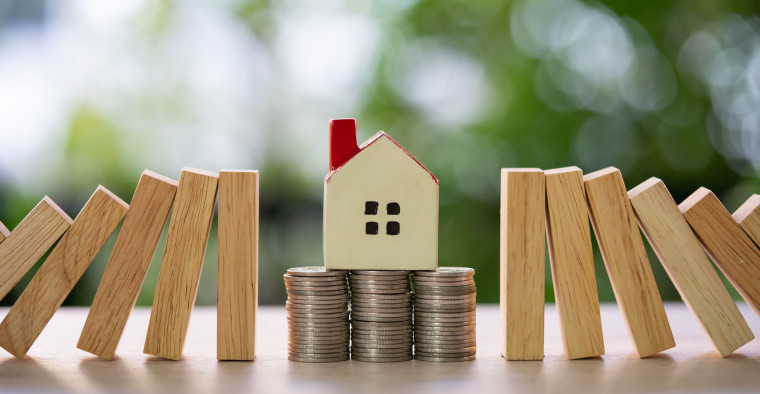
Home insurance costs are climbing.
In the latest ValuePenguin survey of over 2,000 U.S. consumers, 72% of home insurance policyholders reported rate hikes in 2023, with 37% of them citing increases of 5% to 9.99%.
Here’s what else we found.
On this page
- Key findings
- 72% of home insurance policyholders experienced rate hikes in 2023
- Majority expect insurance rate hikes in 2024
- Homeowners have shopped around to save on insurance costs
- 49% have had their current policy for more than 5 years
- 52% of policyholders want federal action in insurance market
- Navigating homeowners insurance amid rate hikes: Top expert tips
- Methodology
Key findings
- Like most things these days, home insurance costs are rising. Among home insurance policyholders, 72% experienced rate hikes in 2023, and 34% say their premiums are more difficult to afford than before. 37% of those who experienced rate hikes in 2023 reported increases of 5% to 9.99% and 24% reported growth of 10% to 29.99%. Whether they experienced rate hikes, policyholders blamed inflation (72%), rising home prices (51%) and climate change (25%) for insurance increases.
- Most policyholders expect insurance rates to continue to climb — and some question future insurability. Three-quarters (75%) expect rate increases this year, and over a quarter (26%) are worried their homes will become uninsurable. This worry is warranted for some, as 19% of policyholders report receiving a nonrenewal notice from their provider.
- Many are weighing options to save money on home insurance. 54% of policyholders have shopped around for homeowners insurance, saving an average of $474 annually. Additionally, 52% of policyholders have asked insurers for discounts, with those successful saving an average of $472 a year. And 28% have downgraded their coverage, saving $414.
- Not everyone reviews their policies, though. Most policyholders (87%) haven’t updated or changed their current home insurance policy in at least a year, with 49% reporting they’ve had their current policy for more than five years. This comes as 37% of policyholders say their insurer has changed the terms of their existing policy — sometimes by raising their deductible (13% of policyholders), adding surcharges (11%) or dropping coverage (8%).
- Americans are split on whether the government should step in. 52% of policyholders think the federal government should intervene in the homeowners insurance market. Younger policyholders are more likely to share this sentiment — 61% of millennials, versus 43% of baby boomers.
72% of home insurance policyholders experienced rate hikes in 2023
Among home insurance policyholders, 72% experienced rate hikes in 2023. By generation, baby boomers ages 60 to 78 with insurance policies were the most likely to experience rate hikes in 2023, at 78%. That’s followed by:
- 73% of millennials ages 28 to 43
- 64% of Gen Xers ages 44 to 59
Meanwhile, those with children 18 or older (75%) and those with children younger than 18 (74%) were more likely than those without children (68%) to experience rate hikes. By income, households earning less than $30,000 (68%) were the least likely to experience rate hikes, while six-figure earners and those earning $30,000 to $49,999 tied as the most likely, at 74%.
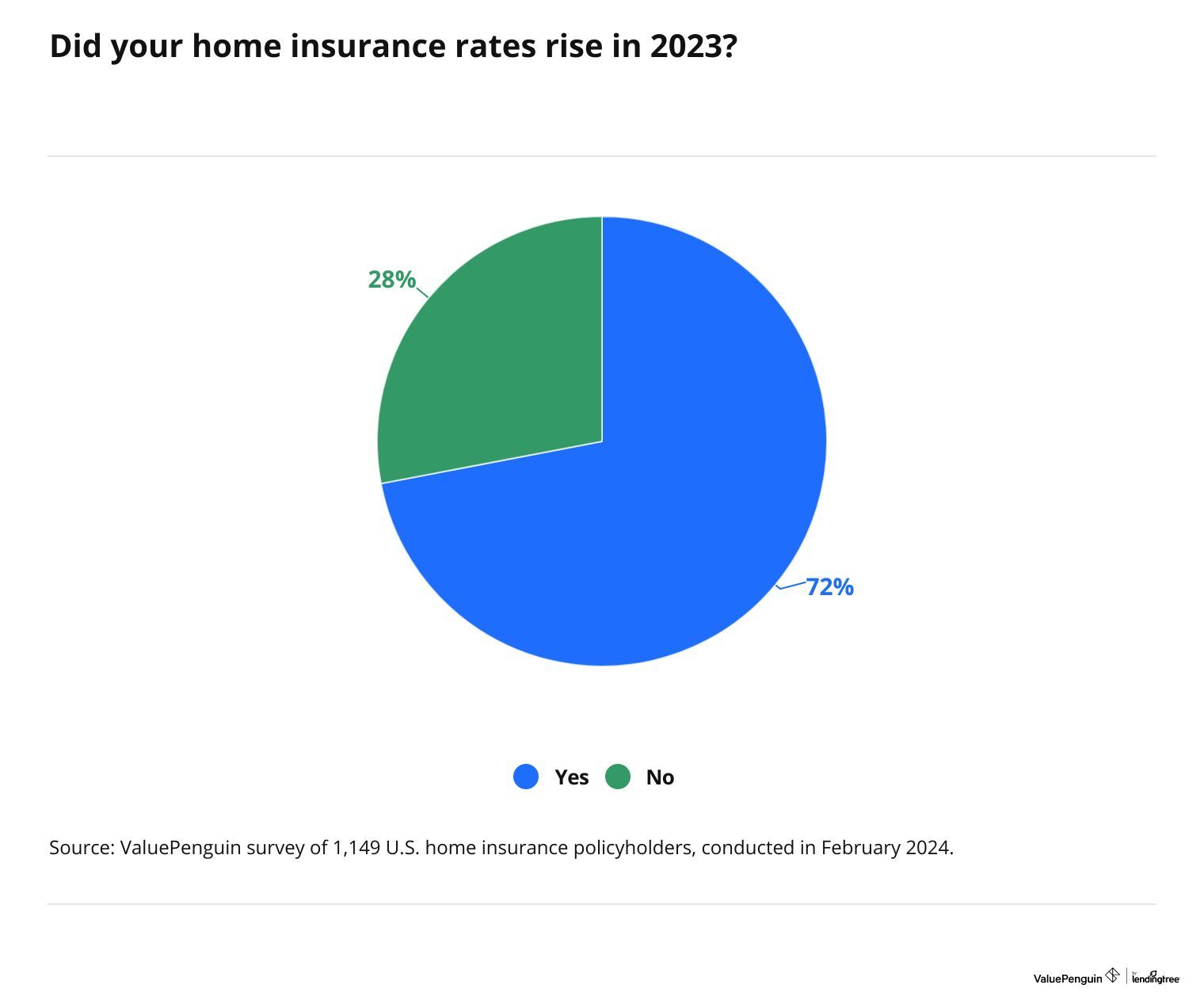
With these rate hikes in mind, 34% of home insurance policyholders say their premiums are more difficult to afford than before. By age group, millennials (41%) are most likely to say they struggle to afford their homeowners insurance, while baby boomers (27%) are least likely.
Those with children younger than 18 (45%) are significantly more likely to share this sentiment than those without children (29%) and those with children 18 or older (28%). Additionally, men (37%) are more likely to have difficulty affording their premiums now than women (31%).
Meanwhile, policyholders earning less than $30,000 (39%) are the most likely to struggle with premium costs now. That compares with 31% of six-figure earners.
How much are homeowners paying for insurance? According to another ValuePenguin analysis, the average cost of homeowners insurance is $126 a month. However, that varies widely by state, ranging from $57 a month in Vermont to $242 a month in Colorado.
As far as how much more they’re paying, 37% of those who experienced rate hikes in 2023 reported increases of 5% to 9.99% — the most common jump. Nearly a quarter (24%) reported increases of 10% to 29.99%. Breaking that down further:
- 26% of this group saw insurance premiums rise less than 5%
- 37% saw premiums rise 5% to 9.99%
- 18% saw premiums rise 10% to 19.99%
- 6% saw premiums rise 20% to 29.99%
- 3% saw premiums rise 30% or more
- 10% don’t know how much premiums rose
Regardless of whether they experienced rate hikes, 72% of insurance policyholders blamed inflation for insurance increases — the most common response. After that, policyholders cited:
- Rising home prices (51%)
- Homeowners filing more claims (35%)
- Insurance company greed (32%)
- Climate change (25%)
- Labor shortages (12%)
Over a quarter (26%) of millennials blamed climate change for raising homeowners insurance premiums. Meanwhile, baby boomers were more likely to cite insurer greed, at 38%. Comparatively, just 29% of millennials said similarly.
Majority expect insurance rate hikes in 2024
There may be more rate hikes. In fact, three-quarters (75%) of policyholders expect rate increases this year, particularly baby boomers (79%), six-figure earners (79%), women (76%) and those with children 18 or older (76%).
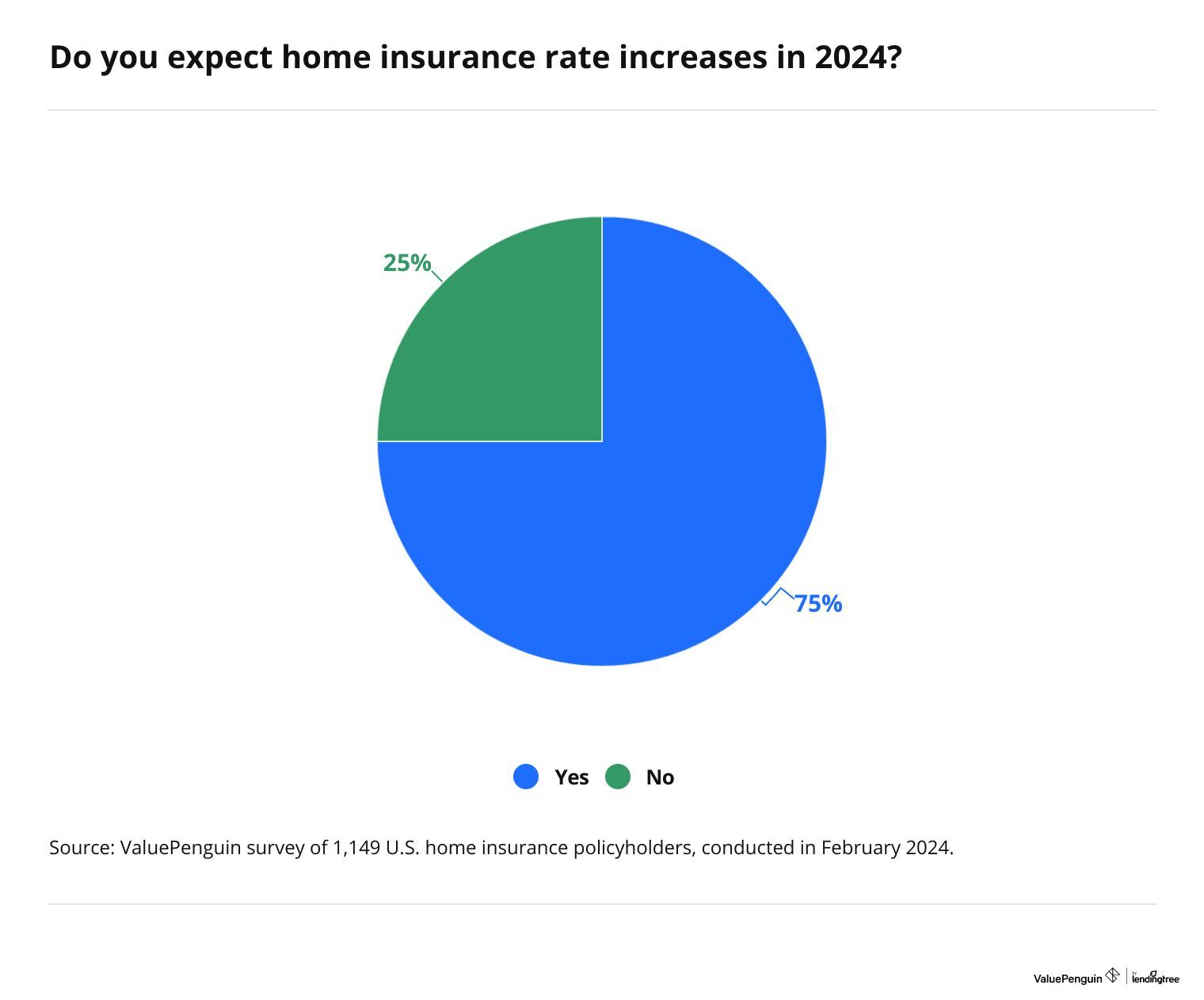
According to ValuePenguin home insurance expert Divya Sangameshwar, policyholders are right to have this expectation.
"A huge part of this comes down to the rising volume and cost of claims," she says. "Climate change has led to increases in the number and severity of hurricanes, floods, tornadoes, drought, heat waves and other harsh weather, which have led to a spike in the volume of claims in many parts of the country."
This also comes as over a quarter (26%) of insurance policyholders are worried their homes will become uninsurable. Alarmingly, 19% of policyholders report receiving a nonrenewal notice from their provider. Millennials (28%) were nearly three times more likely to report a nonrenewal notice from their homeowners insurance provider than their baby boomer counterparts (10%).
As mentioned above, baby boomers (79%) are among the most likely to expect a rate hike in 2024. However, with the majority of baby boomer homeowners (61%) owning their homes outright, they’re also the least likely (18%) to worry about their homes becoming uninsurable.
Homeowners have shopped around to save on insurance costs
With rate increases top of mind for many policyholders, it’s worth noting that 54% have shopped around for homeowners insurance. By age group, millennials (57%) are the most likely to have shopped around, while Gen Xers (49%) are the least likely.
Men (59%) are significantly more likely to have shopped around than women (49%). Meanwhile, those with children younger than 18 (58%) are more likely to have done so than those with children 18 or older (54%) and those without children (48%).
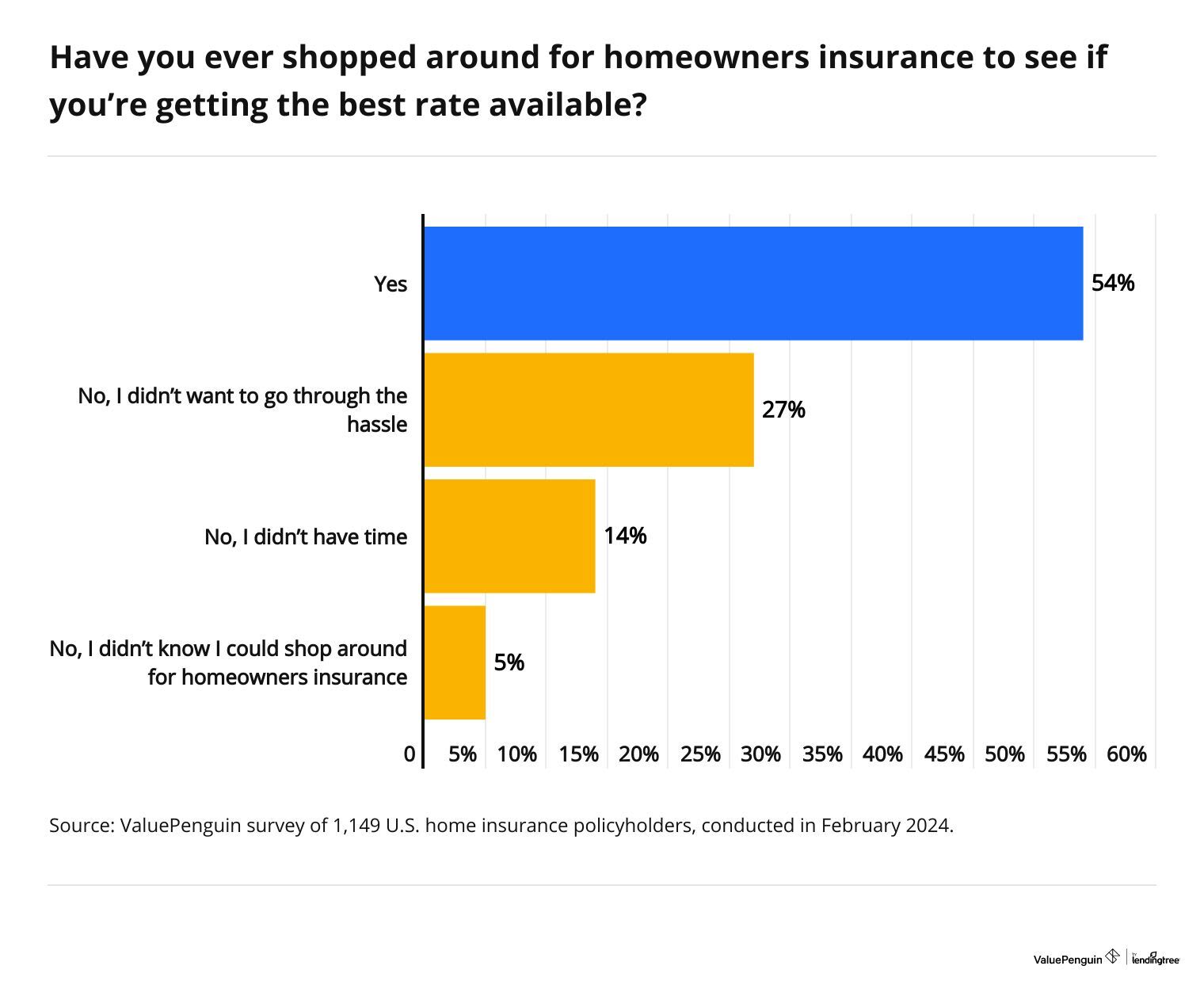
On average, those who’ve shopped around and switched insurance providers saved $474 annually. That rises to $696 among those with children younger than 18, $680 among millennials and $614 among six-figure earners — the highest savings across all demographics.
Sangameshwar says these savings are significant, especially considering that the average cost of homeowners insurance ranges from $680 to $2,900 a year. "In the best-case scenario, shopping around, asking for discounts or downgrading your coverage will reduce your premiums," she says. "At the very least, it can make your rate hikes more manageable."
Meanwhile, 52% of policyholders have asked insurers for discounts, with 36% of policyholders successfully getting their premiums reduced. Those who received discounts saved an average of $472 a year. Meanwhile, 16% of policyholders asked their insurers for discounts but didn’t qualify. As another cost-saving measure, 28% have downgraded their coverage, saving $414. However, 42% of those who downgraded also reported they had to file a claim and pay more out of pocket after downgrading.
Good news for those who received nonrenewal notices, too: Of these policyholders, 79% were able to find coverage again by negotiating with their insurer or shopping around.
49% have had their current policy for more than 5 years
Despite the potential benefits of shopping around, 87% of policyholders haven’t updated or changed their current home insurance policy in at least a year. And 49% of policyholders have had their current policy for more than five years.
While 58% say they review their policy renewal agreement yearly to see if their coverage has changed, a slightly smaller percentage — 49% — say they last reviewed their current policy less than a year ago. Meanwhile, 27% admit they review their policy renewal less than yearly and 15% don’t review their policy renewals.
Across all policyholders, 40% say they last reviewed their policy one to five years ago and 11% say they last reviewed it more than five years ago.
This comes as 37% of policyholders say their insurer has changed the terms of their existing policy, with 13% having raised deductibles — the most common response. Following that, policyholders say their insurer has added surcharges (11%) or dropped coverage (8%).
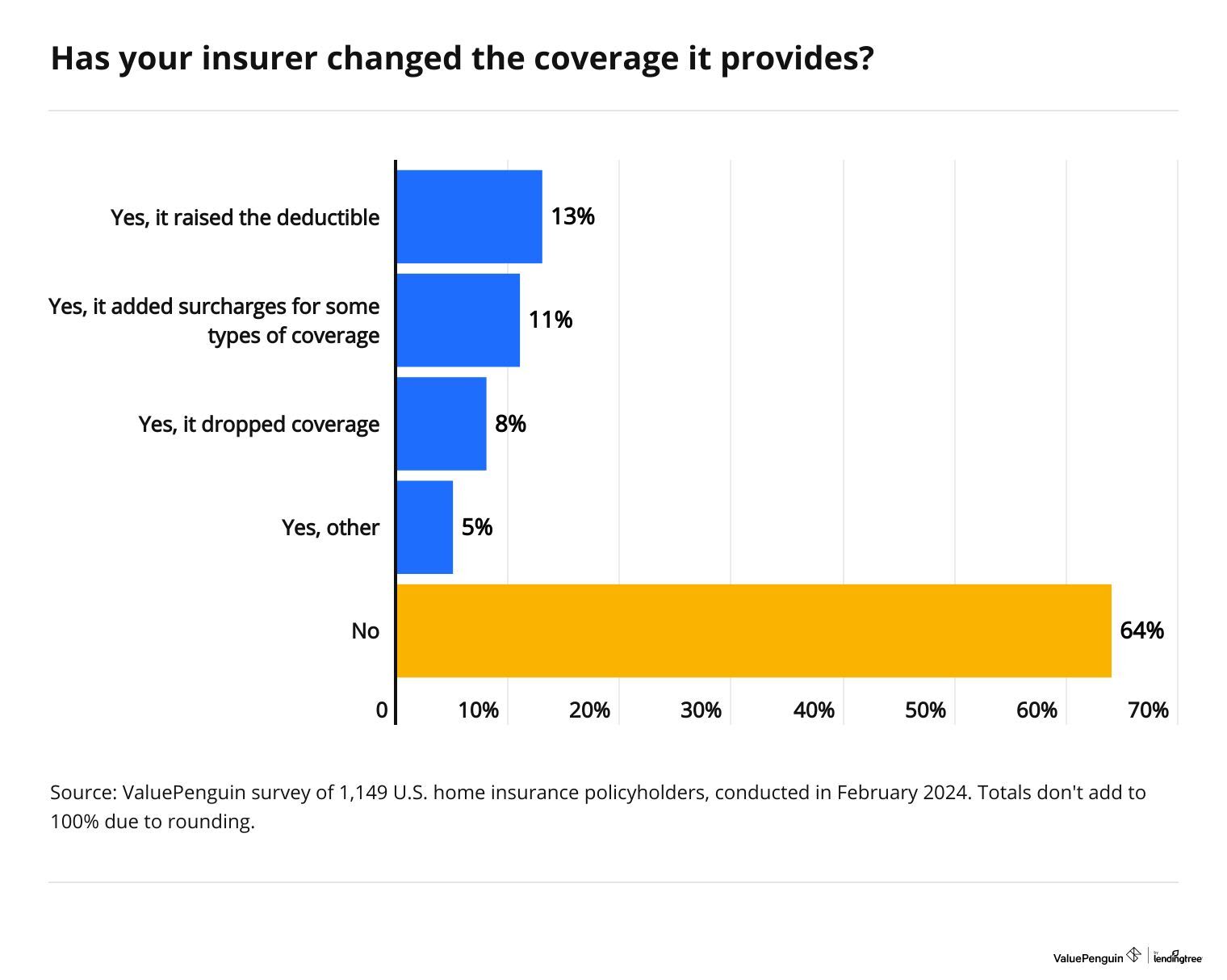
52% of policyholders want federal action in insurance market
With insurance costs increasingly burdensome for homeowners, it may not be surprising that more than half (52%) of policyholders think the federal government should intervene in the homeowners insurance market.
Younger policyholders are more likely to feel this way: While 61% of millennials think the government should step in, just 43% of baby boomers say similarly. Meanwhile, those with children younger than 18 (61%) are significantly more likely to want government action than those without children (49%) and those with children 18 or older (46%).
Men (56%) are more likely to share this sentiment than women (48%).
While there aren’t federal regulations around homeowners insurance, the Incorporating National Support for Unprecedented Risks and Emergencies (INSURE) Act, introduced in January 2024, could be a first step toward stabilizing the home insurance market, ensuring homeowners aren’t excluded from coverage.
However, Sangameshwar says focusing on lowering insurance rates alone won’t address the bigger issues that impact those rates — and, in the long term, can lead to fewer insurers willing to underwrite homeowners insurance policies.
"For the average homeowner, this could mean fewer options with less coverage or being uninsurable," she says. "Any solution to fixing the rising homeowners insurance rates also needs to address the issues causing an increase in the volume and cost of claims — namely inflation, outdated building codes, building homes in high disaster risk areas and climate change."
Navigating homeowners insurance amid rate hikes: Top expert tips
If you’re struggling to afford your homeowners insurance after experiencing a rate hike, there are a few things worth doing — and a few things you shouldn’t do.
- The worst thing you can do when faced with a rate hike is to drop your coverage. "Not only will you put yourself at risk for significant financial losses if disaster strikes, but a gap in your home insurance coverage will make it harder for you to find affordable coverage in the future," Sangameshwar says.
- The other thing to avoid is doing nothing or procrastinating. "An insurer will send you a renewal notice roughly 30 to 60 days before the end of your policy period," she says. "It’s important to use that time to review the new policy and shop around for discounts or a better rate to save."
What should you do?
- Review your homeowners insurance policy and make sure you have enough coverage before making any decisions. "It’s important to know what kind of coverage you have and if it reflects the price of rebuilding your home or the value of your personal belongings," she says. "It’s also important to check if you’re protected against disasters your town is most prone to. Some insurers don’t automatically include protection against windstorms or wildfires and require homeowners to buy additional coverage. If you need to update your coverage, call your insurer to ask how much it’ll cost. You should use that updated quote to shop around."
- Make updates to your home to reduce extreme weather risk. This includes repairing previous storm damage in a timely manner, regularly inspecting and repairing damage to your roof and siding, installing hail-resistant roofs and hurricane shutters, trimming trees and securing outdoor furniture. Taking steps like these will also reduce your risk of nonrenewals and can help qualify you for home insurance discounts.
Methodology
ValuePenguin commissioned QuestionPro to conduct an online survey of 2,035 U.S. consumers ages 18 to 78 from Feb. 1 to 5, 2024. The survey was administered using a nonprobability-based sample, and quotas were used to ensure the sample base represented the overall population. Researchers reviewed all responses for quality control.
We defined generations as the following ages in 2024:
- Millennial: 28 to 43
- Generation X: 44 to 59
- Baby boomer: 60 to 78
